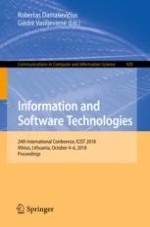2018 | Book
Information and Software Technologies
24th International Conference, ICIST 2018, Vilnius, Lithuania, October 4–6, 2018, Proceedings
Editors: Robertas Damaševičius, Giedrė Vasiljevienė
Publisher: Springer International Publishing
Book Series : Communications in Computer and Information Science
